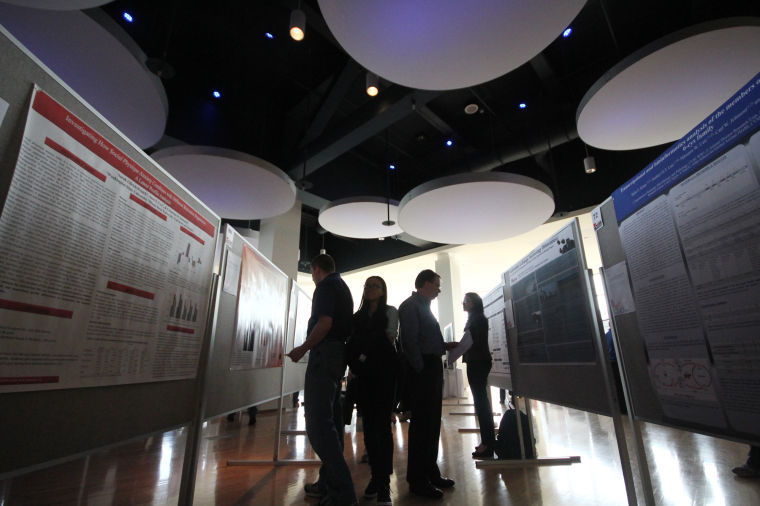Showcasing research
Community members browse research posters during the Showcase for Undergraduate Research and Creative Activities in the CUB Senior Ballroom, Friday, March 28.
March 31, 2014
WSU celebrated students, faculty and staff last week for their achievements in a wide range of academic disciplines, from genetically engineered medieval crops to the history of U.S. opinion on Taiwan.
The event, called WSU Showcase, was a culmination of several efforts to recognize achievements within the university. One part of the event was the Showcase for Undergraduate Research and Creative Activities (SURCA) in which more than 150 students participated.
“Including SURCA, Showcase is a wonderful opportunity for undergraduate students to present their research at the same level as faculty,” said Shelley Pressley, the director of undergraduate research and an assistant research professor in the Department of Civil and Environmental Engineering. “I think all the research and scholarly and creative activities at WSU set a great example for what the university does.”
Showcase began Thursday afternoon in the Veterinary and Biomedical Research Building with a presentation by Raymond Reeves, a professor in the School of Molecular Biosciences. The presentation was titled A Surprising Path to Regenerative Medicine.
The event resumed Friday morning in the CUB Senior Ballroom, where faculty, staff, graduate and professional students displayed their research and creative endeavors.
One researcher, Shelly Fritz, a doctoral nursing student from the Spokane campus, presented her work in developing a home-installed system that monitors behavioral patterns like sleeping and eating.
Fritz said the system is intended for use in the homes of elderly people who are prone to sudden medical emergencies like falls and heart attacks. She said the project might eliminate the need for live-in nurses and those who drive long distances to check on their patients.
“What’s really nice about this is that you don’t have to wear it around your neck,” she said, noting that many users of the monitoring system Life Alert tend to remove their necklaces frequently.
The system uses motion sensors linked to a central server, and software under development will use the collected information to recognize changes in behavioral patterns.
Susan C. Wang, an assistant professor in the School of Molecular Biosciences, presented research she conducted alongside clinical associate professor Philip F. Mixter.
Using an educational style Wang called “active learning,” she and Mixter found that increased use of pop quizzes and other comprehension exercises enabled students to perform better in Microbiology 305, a class which she said produces extremely low average grades.
“We basically got rid of all the Fs,” she said.
Wang noted that their observations were not consistent across the several classes they studied.
Undergraduates took the spotlight when the SURCA competition began at noon.
Freshmen through seniors shared original contributions in their respective fields through oral presentations and poster viewings that were open to the public. One study abroad student presented from overseas by teleconference.
Projects were judged by a panel of more than 100 individuals from the university and the Pullman-Moscow community. Boeing awarded money to several winners in each of eight academic categories, 37 winners in all.
Awards included the Crimson Award for $300, the Gray Award for $200, and the Novice Award for $150.
Assistant Vice Provost for Undergraduate Education Mary Sanchez-Lanier said winners of the novice award “were judged to show exceptional promise” early in their careers.
The first SURCA event was in 2012. In previous years, colleges and departments held their own symposiums to recognize student and faculty achievement.
Pressley said the event required months of planning and making improvements to the judging rubric.





















